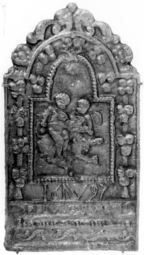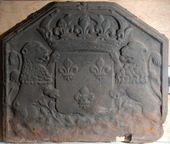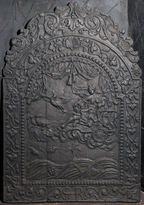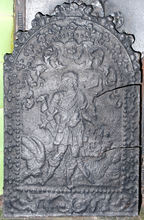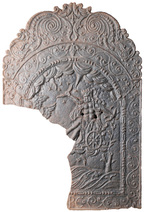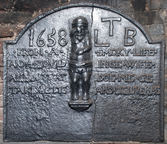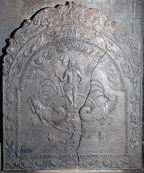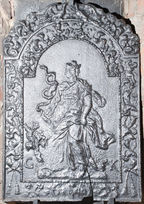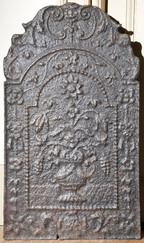-
187
Description: 'Dutch' style; arched rectangular shaped central panel, bead edging, two children sitting astride a beast (possibly a winged ram); arched rectangular shaped border, fillet edging, swags of fruit bunches suspended from ribbon; on top, symmetrical floral swirls and flowers.
Notes: The image is probably intended to be Phryxus and Helle riding the winged ram with the golden fleece, but in recasting it has been misinterpreted as the young Samson slaying the lion at Timnath; Judges 14: 5-6. Formerly part of the Ade Collection (from Grove Hill, Hellingly, Sussex).
Copies of this fireback are known.
Inscription: 16 NDW 97 / DER IUNGE SAMSON [the young Samson]
- Decoration tags:
- 'Dutch' (shape)
- fillet (edging)
- whole carved pattern
- mythological
- monogram
- text
- humans
Manufactured: in 1697 possibly in the Siegerland area of Germany.
Current location: Hastings Museum and Art Gallery, John's Place, Bohemia Road, Hastings, East Sussex, England.
Museum number: HASMG 1952.51.28 (part of the Hastings Museum museum group)
- Attached to series:
- 'Dutch' NDW series
-
938
Description: Rectangular with three-facetted arch; fillet edging; shield, crown and lion supporters of the French royal house of Valois.
Notes: The arms date to before 1589 when the House of Valois was succeeded by the House of Bourbon. Lion supporters on the French royal arms are not common.
Arms: France Royal
- Decoration tags:
- rectangular with three-facetted arch (shape)
- fillet (edging)
- whole carved pattern
- planklines
- armorial
Manufactured: in the late-16th century in France.
Current location: not known.
- Attached to series:
- Foreign armorial firebacks
-
327
Description: Arched rectangular shaped central panel with open-bud edging; pictorial: Venus in her chariot drawn by doves, with her child, Cupid; a heron flies away to the left; above are swagged curtains and a pair of tassels, below is a landscape; arched rectangular shaped border with fillet edging, a scallop shell top centre with symmetrical arrangement of vine and acanthus leaves and tendrils; the monogram, SHR, bottom centre; above is a symmetrical design of scrolled floral tendrils.
Notes: The design is derived from a personification of the planet Venus in 'Planetarum effectus et eorum in signis zodiaci', by Marten de Vos (1585). Two editions of engravings of de Vos's drawings are known, by Jan Sadeler, dated 1585, and by Gregor Fentzel in about 1650. The flying heron has been copied from a print by Wenceslaus Hollar c.1658. The theft, in 1699, from a Thames-side warehouse of several firebacks, included '6 of Venus in a Chariot with Doves', which is likely to refer to this type (Post Boy 11-14 Nov. 1699).
Copies of this fireback are known.
Inscription: SHR
- Decoration tags:
- 'Dutch' (shape)
- fillet (edging)
- whole carved pattern
- planklines
- pictorial
- mythological
- allegorical
- text
- animals
- humans
Manufactured: in the late-17th century in England.
Current location: Horsham Museum, Causeway, Horsham, West Sussex, England.
(part of the Horsham Museum museum group)
- Attached to series:
- SHR series
- British 'Dutch' style firebacks
- De Vos Planets series
-
328
Description: Arched rectangular central panel with bead edging; pictorial scene of a figure in Roman dress, holding a large sword, and holding the head of a bearded man in his left hand; below to the left, a naked, decapitated body; above the winged face of a putto between mirrored, scrolled foliage; arched rectangular border with fillet edging; flowers in chain under the arch and down the sides; at the bottom, swirled foliage; on top, a crown between fruit triads.
Notes: Perseus holding the severed head of the Medusa; possibly loosely adapted from a drawing by Crispijn de Passe the elder (1564-1637). Similarities in the design and execution of the pattern suggest a common source with contemporary English firebacks.
- Decoration tags:
- 'Dutch' (shape)
- fillet (edging)
- whole carved pattern
- pictorial
- mythological
- humans
Manufactured: in the early-18th century in England.
Current location: Horsham Museum, Causeway, Horsham, West Sussex, England.
(part of the Horsham Museum museum group)
- Attached to series:
- British 'Dutch' style firebacks
-
325
Description: Arched rectangular shaped central panel with bead-and-pellet edging on a broad fillet; Jupiter in his chariot drawn by eagles; above are clouds, below is a landscape; arched rectangular shaped border with fillet edging, with a symmetrical scrolled wire design; the monogram, SHR, bottom centre; above is a symmetrical design of scrolled floral tendrils.
Notes: The design is probably adapted from a personification of the planet, Jupiter, in 'Planetarum effectus et eorum in signis zodiaci', by Marten de Vos (1585). Two editions of engravings of de Vos's drawings are known, by Jan Sadeler, dated 1585, and by Gregor Fentzel in about 1650.
Inscription: SHR
- Decoration tags:
- 'Dutch' (shape)
- fillet (edging)
- whole carved pattern
- pictorial
- mythological
- allegorical
- text
- humans
Manufactured: in the late-17th to early-18th century in England.
Current location: Horsham Museum, Causeway, Horsham, West Sussex, England.
(part of the Horsham Museum museum group)
- Attached to series:
- SHR series
- British 'Dutch' style firebacks
- De Vos Planets series
-
337
Description: Arched rectangular shaped; ovolo moulded edging (top and sides); central stamp of a carved bracket figure of a bearded man in a loincloth and cap; date and monogram in arch, split by figure, ‘T’ elevated; rhyme in capitals across centre, letters carved on strips, split by figure; date and initials as individual stamps.
Notes: The twin miseries of a smoky house and a scolding wife are mentioned several times in literature. The dress of the figure suggests work as a miner, possibly linking this back with the Forest of Dean. Variants exist without date or initials, or with other dates. A version of this fireback with the date 1660, instead of 1658, was noted at Bellamy's Farm, Longney, Gloucestershire in 1912 (Notes and Queries, 11th ser., 6 (Sep 1912), p.230.).
Copies of this fireback are known.
Inscription: 1658 LTB; ·FROM ·A·-·SMOKY ·LIFE·/ AND·A SCOVL DING·WIFE·/ALL MEN THAT-DOE·ME·SE/ TAKE·PETIE- AND·DELIVER ME
- Decoration tags:
- rectangular with round arch (shape)
- fillet (edging)
- carved stamps
- individual letters
- individual numbers
- text
- humans
Manufactured: in 1658 possibly at Tintern Furnace in the Forest of Dean area of Wales.
Current location: in private hands, Huddington, Worcestershire, England.
Citation: Chambers, L. H., 26 Sep 1912, 'Fireback: Relic of 1660', Notes and Queries, 11th series, 6, p. 230.
-
341
Description: Arched rectangular shaped central panel with ’nutshell,’ paternost edging on a broad fillet; figure of Neptune/Poseidon holding a trident in his right hand, standing on a pedestal in the centre of a circular fountain, with two hippocampi, water issuing from their mouths; in front, a mermaid swims in waves, her arms raised; behind, blasts of wind issue from clouds; arched rectangular border with fillet edging; symmetrical design of seashells suspended from chains of pearls; bottom centre, the monogram between swirled plant tendrils; on top, symmetrical floral swirls.
Notes: Although very similar in size and design to a fireback in the 1724 series, this is not based on a design by Daniel Marot; instead it may have been inspired by the design for a fountain by Jean Lepautre (1618-82) published in a set of 12 etchings by Jean Le Blond in 1650. Almost certainly the 'iron chimney back' purchased by Henry Campion, of Danny, from John Legas for two guineas in 1731; another example, presumably from the same source, is at The Vine, near Basingstoke, Hampshire.
Copies of this fireback are known.
Inscription: SHR
- Decoration tags:
- 'Dutch' (shape)
- fillet (edging)
- whole carved pattern
- pictorial
- architectural
- text
- animals
- humans
- objects
Manufactured: in the early-18th century possibly at Gloucester Furnace, Lamberhurst in the Weald area of England.
Current location: Danny House, Hurstpierpoint, West Sussex, England.
Citation: Brent, C. & J., 2013, Danny House (Chichester, Phillimore), pp. 58-9.
- Attached to series:
- SHR series
- British 'Dutch' style firebacks
-
981
Description: Arched rectangular shape; fillet edging; broad, fillet-edged central panel with pictorial landscape and battle scene; on top, above a cone of laurel leaves, a crown supported by two putti, each holding a plant stem; on each side, a flower and fruit festoon suspended on a ribbon from a ring; at the bottom , inscription on a scroll.
Notes: The pictorial scene is alleged to be the Siege of Namur of 1695 in which British and Dutch forces, under the leadership of William III, defeated the French forces of Louis XIV, however details of the scene more closely resemble those seen in images of the Siege of Vienna in 1683, an iconic victory of the Christian powers over the Ottoman Turks.
Copies of this fireback are known.
Inscription: NON[...]ROSEDARMIS / N ANNO 1695 L
- Decoration tags:
- 'Dutch' (shape)
- fillet (edging)
- whole carved pattern
- individual letters
- pictorial
- text
- animals
- humans
- plants
- objects
Manufactured: in 1695 possibly in the Siegerland area of Germany.
Current location: Swakeley's House, Ickenham, Middlesex, England.
Citation: Godfrey, W. H., 1933, Survey of London Monograph 13, Swakeleys, Ickenham (London, HMSO).
- Attached to series:
- 'Dutch' 1695 Crown series
-
344
Description: Arched rectangular central panel, with bead-and-pellet edging; pictorial, standing female figure in classical dress, facing to the left, holding a snake in her right hand, a bunch of flowers at lower left; the initials located in bottom corners; arched rectangular border, fillet edging, containing swirled foliage, with a putto in the top corners; on top, two perched bird facing each other, with swirled foliage descending behind them.
Notes: The figure is of Sapientia, or Wisdom, based closely on an engraving, one of a set entitled 'The Virtues' by Hendrik Goltzius c.1593; a small number of firebacks bear the initials, GK; it is not known to whom they refer, but dated ones are of 1700.
Copies of this fireback are known.
Inscription: G K
- Decoration tags:
- 'Dutch' (shape)
- fillet (edging)
- whole carved pattern
- pictorial
- allegorical
- text
- humans
Manufactured: in the early-18th century in the Siegerland area of Germany.
Current location: Ightham Mote, Ightham, Kent, England.
Museum number: 825381 (part of the National Trust museum group)
- Attached to series:
- 'Dutch' GK series
-
1117
Description: Arched rectangular shaped central panel, bead edging, narrow-necked urn with swagged decoration and gadrooned base, flowers issuing therefrom; arched rectangular shaped border with fillet edging and symmetrical floral festoons; on top, mirrored plant fronds descending from a small mask; at the bottom, an indistinct cartouche and a probable letter 'W' between swirled foliage.
Notes: Small firebacks of this type and period might have been cast at one of the London foundries and used for attaching to the rear of dog grates. The initial 'W' probably denotes the pattern maker.
Inscription: W
Manufactured: in the late-17th to early-18th century possibly in the London area of England.
Current location: in private hands, Isleworth, London, England.
- Attached to series:
- British 'Dutch' style firebacks
- W series
